Yoga is a very old practice, thought to be thousands of years old. According to history, the first yogi and guru, known as Adiyogi, taught yoga to seven wise sages called Saptarishis. These sages then shared yoga with people all around the world.
The word “Yoga” comes from the Sanskrit word “Yuj,” which means coming together or unity. Yoga is all about bringing together your mind, body, and the natural world around you. It has been found to help with various health issues like mental well-being, weight loss, bone problems, and brain function.[1]
How does yoga help with stomach problems?
Ayurveda and Yoga are like close siblings in the world of health. When you practice them together, it can make a big positive impact on your well-being. Ayurveda teaches us that when we have health problems, it’s often because of an imbalance in three elements called Doshas. These Doshas are named Vatta, Pitta, and Kapha. When these three are in balance, you’re healthy, but when one is out of balance, it can cause various health issues.
For example, stomach problems often happen because our digestion isn’t working well. According to Ayurveda, this happens when there’s an imbalance in the Vatta Dosha, which is related to the air element. Vatta Dosha is responsible for how our digestive organs function. To fix stomach problems, we can turn to Yoga.
Yoga has different poses and exercises that help balance these three Doshas. Some Yoga poses specifically help calm our Vatta Dosha, which in turn helps with stomach issues. These Yoga poses also involve proper breathing techniques that benefit your digestive organs.
Yoga Asanas for Gastric Related Problems
1. Wind-Relief Pose (Pawanmuktasana)
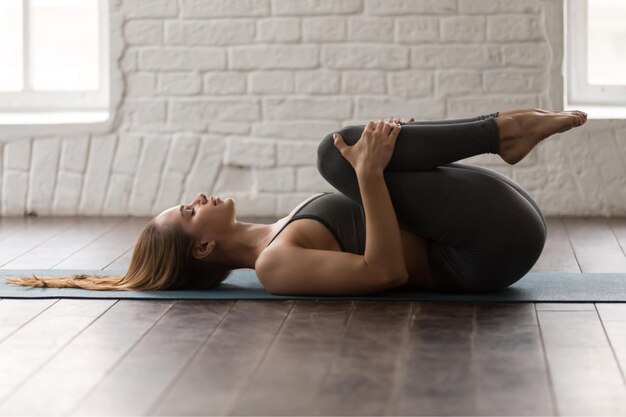
The Wind-Relief Pose, also known as Pawanmuktasana, is a yoga pose that can help you with gas troubles.
The name “Pawanmuktasana” comes from two words: “Pawan,” which means wind or gas, and “Mukta,” which means release or relief. This pose is all about helping your body get rid of gas that can build up in your stomach, usually because of problems digesting food. When you have gas, it can cause more than just an uncomfortable feeling in your stomach; it can also lead to issues like headaches and joint pain.
Here’s how to do it:
- Start by lying flat on your back on a mat. Stretch your arms and legs out and take a few deep breaths. This is the starting position, also known as Savasana.
- Bend your knees so that your legs make a 90-degree angle with your thighs.
- Exhale and bring your knees closer to your chest.
- At the same time, lift your head to bring it closer to your knees.
- Hold this position for a few seconds, and then release.
- Keep your breathing normal while you hold the pose.
This pose can help relieve gas and also works on muscles in your back, biceps, triceps, and hips.
2. Child’s Pose (Balasana)
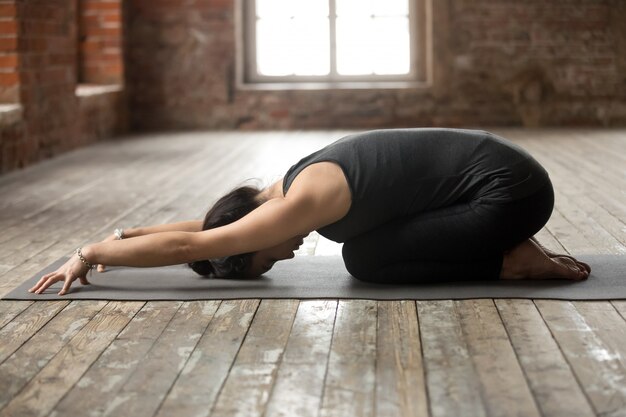
Child’s Pose, also known as Garbhasana and Shashankasana, is a yoga position that resembles a child resting. In Balasana, “Bala” means child, and “asana” means posture or pose. This yoga pose is often done at the end of a yoga session, and it’s all about practicing proper breathing.
The main idea is to breathe slowly and steadily. When you bend or flex your body, you exhale, and when you stretch, you inhale.
Here’s how to do it:
- Sit on your heels with your knees bent, like you’re kneeling (this is called Vajrasana).
- Begin with an exhale. Raise your arms up, keeping them in line with your shoulders.
- Bend at your hips and start moving your upper body forward until your forehead touches the floor.
- Hold this position for a few seconds while breathing normally.
- To return to the starting position, inhale and slowly come back up.
Child’s Pose offers several benefits:
- It helps relieve feelings of tiredness, anxiety, and stress.
- It aids in improving digestion.
- It can provide relief from back pain.
So, it’s a gentle and calming yoga pose that can help you relax and feel better.
3. Seated Forward Bend (Paschimottanasana)
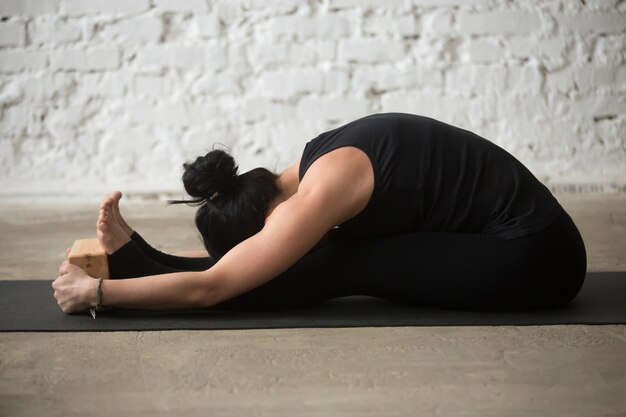
Seated Forward Bend, also known as Paschimottanasana, is a basic yoga pose that you do while sitting down. It’s a simple yoga position that focuses on making your hip joints more flexible.
Here’s how it can help you:
- Better Digestion: When you stretch your body forward, it puts pressure on your digestive organs. This can improve your digestion and help with stomach problems.
- Relaxation and Stress Reduction: This pose can also make your whole body feel relaxed and calm. It’s good for reducing stress and tension.
- Back Health: If you have back pain, this pose can be helpful. It exercises your spine and can give it a healthier shape.
- Diabetes and Liver Health: Some people with diabetes or liver issues have found this pose beneficial.
Here’s how to do it:
- Sit on a mat with your legs stretched out in front of you.
- Inhale, and as you breathe in, raise your arms above your head, reaching towards the ceiling.
- Exhale and slowly bend forward from your lower back, keeping your hands moving towards your feet and your chest closer to your knees.
- Hold this position for a few seconds, breathing normally. Keep your knees and head down.
- Inhale again as you return to the starting position.
So, it’s a yoga pose that’s good for your digestion, relaxation, spine health, and it might even be helpful if you have certain health issues like diabetes or liver problems.
4. Twisted Spine Pose (Supta Matsyendrasana)

Supta Matsyendrasana might sound like a complex name, but it’s a yoga pose that can be quite helpful. Let’s break it down:
- Supta means to recline, like when you lie down.
- Matsya refers to fish.
- Endra points to Lord Indra, a figure in ancient stories.
So, when you put it all together, it’s sometimes called the “Lord of the Fishes Pose.” This yoga pose is a bit of a twist, and it’s related to another pose called Ardha Matsyendrasana, which is done while sitting. Supta Matsyendrasana focuses on your spine and abdomen by gently twisting them.
Here’s how it can benefit you:
- Flexibility: It makes your spine more flexible and keeps it in good shape.
- Back Pain: This pose can reduce the chances of getting backaches.
- Sleep Aid: It might help people with sleep problems like insomnia by relaxing the body and mind, making it easier to fall asleep.
- Digestion: It’s good for your digestion and can help with stomach issues.
- Organ Exercise: This pose also exercises your internal organs, keeping them healthy.
Here’s how to do it:
- Lie down on your back on a yoga mat.
- Stretch your arms out to the sides so they are in line with your shoulders.
- Exhale, and bend your right knee towards your chest. Cross it over your body so that it touches the floor on your left side.
- At the same time, turn your head to face the left.
- Hold this position for a few seconds, and then return to the starting position.
- Repeat the same with your other leg.
- Inhale, come back to the center, and then exhale as you switch to the other side. Keep breathing normally.
So, it’s a yoga pose that gently twists your spine and abdomen, which can be good for your overall health, flexibility, and relaxation.
5. Happy Baby Pose (Ananda Balasana)
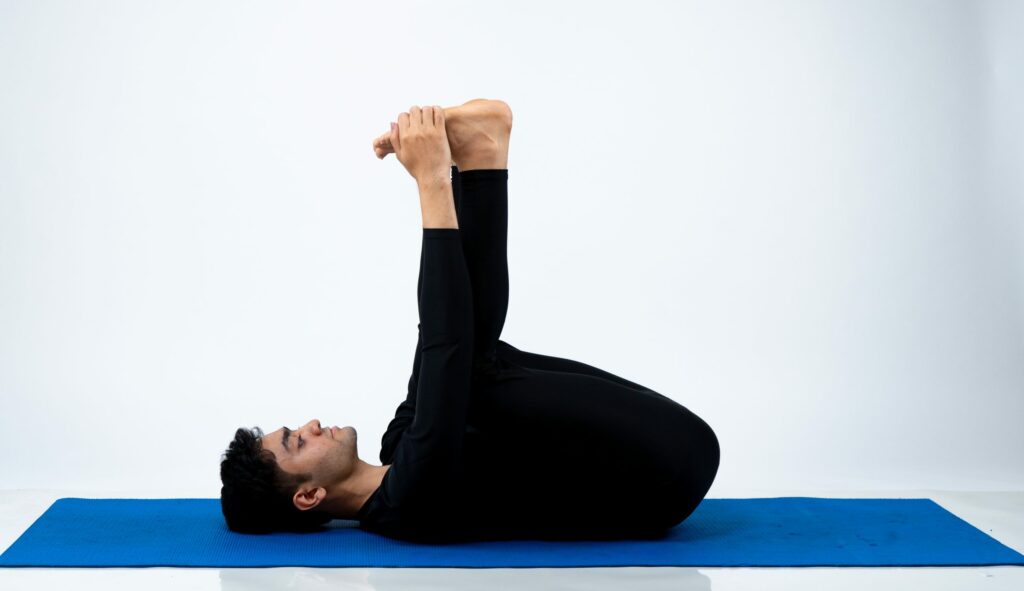
Ananda Balasana is a yoga pose that’s like a cheerful baby’s pose. It’s a bit like a happy baby or even a bug on its back, but we prefer to call it the happy baby pose because it sounds more positive.
Here’s why it’s called the happy baby pose:
- Ananda means feeling content or happy.
- Bala means baby.
So, this pose is all about feeling content like a happy baby. People also sometimes call it the “dead bug pose” because it might look a bit like a bug turned over, but we like to focus on the happy part.
Ananda Balasana is often done at the beginning of a yoga session to warm up and prepare for more intense poses.
Here’s what it can do for you:
- Stretching: It stretches your hip, thigh, bicep, and tricep muscles.
- Heart Health: It can improve your heart rate.
- Spine Health: It helps your spine stay in a good shape and lengthens it.
- Back Pain Relief: If you have lower back pain, this pose can be helpful.
- Digestion: It’s also good for digestion and can help with stomach issues.
Here’s how to do it:
- Lie down on your back on a yoga mat.
- Exhale and bend your knees towards your chest.
- Try to hold your feet’s big toes with your hands.
- Hold this position for a few seconds while breathing normally.
- When you’re ready, inhale and release your feet and legs to go back to the starting position.
So, it’s a yoga pose that can make you feel like a happy, content baby. It stretches your muscles, helps your heart, and is good for your back and digestion.
Conclusion
In conclusion, practicing specific yoga asanas can be a valuable and natural way to alleviate gastric problems and improve overall digestive health. These yoga poses, such as Pawanmuktasana, Balasana, Paschimottanasana, Supta Matsyendrasana, and Ananda Balasana, offer a range of benefits that extend beyond just soothing stomach discomfort.
Regularly incorporating these poses into your yoga routine can help increase flexibility, relieve back pain, promote relaxation, aid digestion, and even enhance heart health. Moreover, the holistic approach of yoga, which combines physical postures with controlled breathing and mindfulness, contributes to a sense of overall well-being.
FAQs
Yes, yoga can be effective in alleviating gastric problems. Certain yoga asanas (poses) help in improving digestion, reducing gas, and relieving stomach discomfort.
Many of the mentioned yoga poses, such as Pawanmuktasana and Balasana, are beginner-friendly. However, it’s important to start slowly and gently, and consider seeking guidance from a certified yoga instructor, especially if you’re new to yoga.
Consistency is key. Practicing these poses a few times a week, preferably on an empty stomach, can help you experience the benefits. Listen to your body and increase the frequency as you become more comfortable.
Yoga can be a complementary approach to managing chronic conditions like acid reflux or irritable bowel syndrome (IBS). While it may not provide a cure, it can help alleviate symptoms and improve overall digestive health when combined with other treatments and lifestyle changes.
If you have any existing medical conditions or are pregnant, consult with a healthcare professional or a qualified yoga instructor before starting these poses. It’s important to perform them mindfully and avoid overexertion.

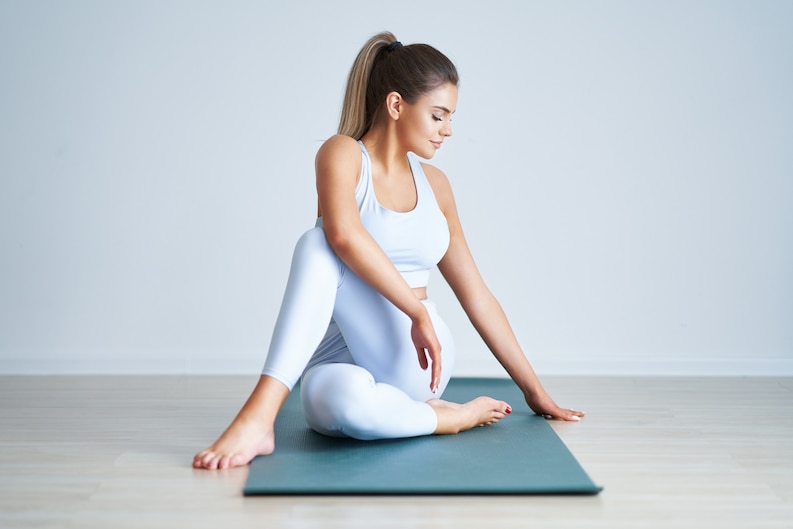


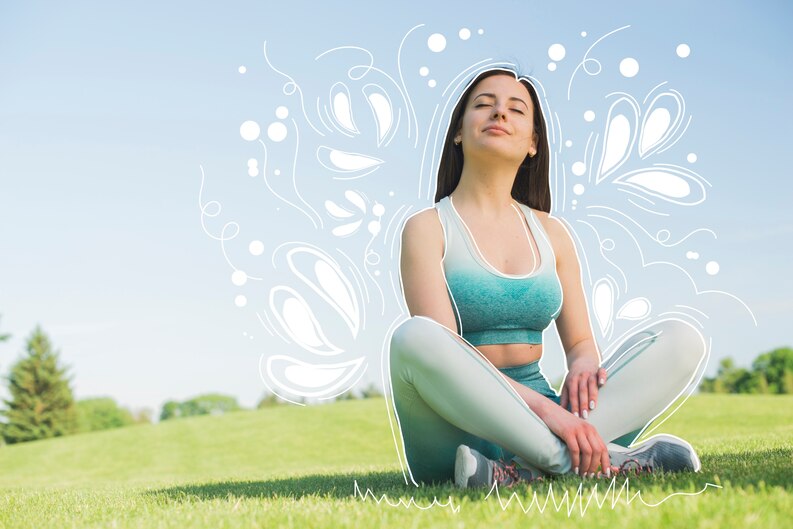


Leave a Reply